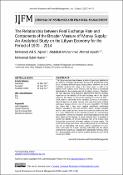Options
The Relationship between Real Exchange Rate and Components of the Broader Measure of Money Supply An Analytical Study on the Libyan Economy for the Period of 1970 – 2014
Journal
Journal of Insurance and Financial Management
Date Issued
2017
Author(s)
Mohamed Ali S. Ajredi
Abdullah Mohammed Ahmed Ayedh
Mohamad Sabri Haron
Abstract
The Libyan economy had achieved a level of growth and stability for its currency exchange rate through the plans of development using fiscal, monetary and trade expansionary policies. However, due to the instability witnessed by Libya in the recent years, as well as the decline in the volume of oil revenues, this has led to a remarkable deterioration in the exchange rates of the Libyan currency. Therefore, the main objective of this study is to determine the effect of monetary expansion on the stability of the real exchange rate in the Libyan economy, relying on annual data covering the period of 1970 – 2014, which is represented in the variables (Currency in circulation, demand deposits and quasi- money), using time-series analysis techniques through Johnson’s test of the joint integration, which has shown the results of a long- term negative equilibrium relationship between variables in line with economic theory. Granger causality test has been applied as well, where the results have shown that there is a causal relationship in one direction between the real exchange rate and both currency in circulation and demand deposits in the short term. Based on these results, the study concludes that it is possible to control the stability of the real exchange rate of the Libyan dinar through the components of broader measure of money supply.
File(s)
Loading...
Name
The Relationship between Real Exchange Rate and Components of the Broader Measure of Money Supply An Analytical Study on the Libyan Economy for the Period of 1970 – 2014.pdf
Description
The Relationship between Real Exchange Rate and Components of the Broader Measure of Money Supply An Analytical Study on the Libyan Economy for the Period of 1970 – 2014
Size
1.04 MB
Format
Adobe PDF
Checksum
(MD5):35d4469c55954823163f80b2eec1fa15